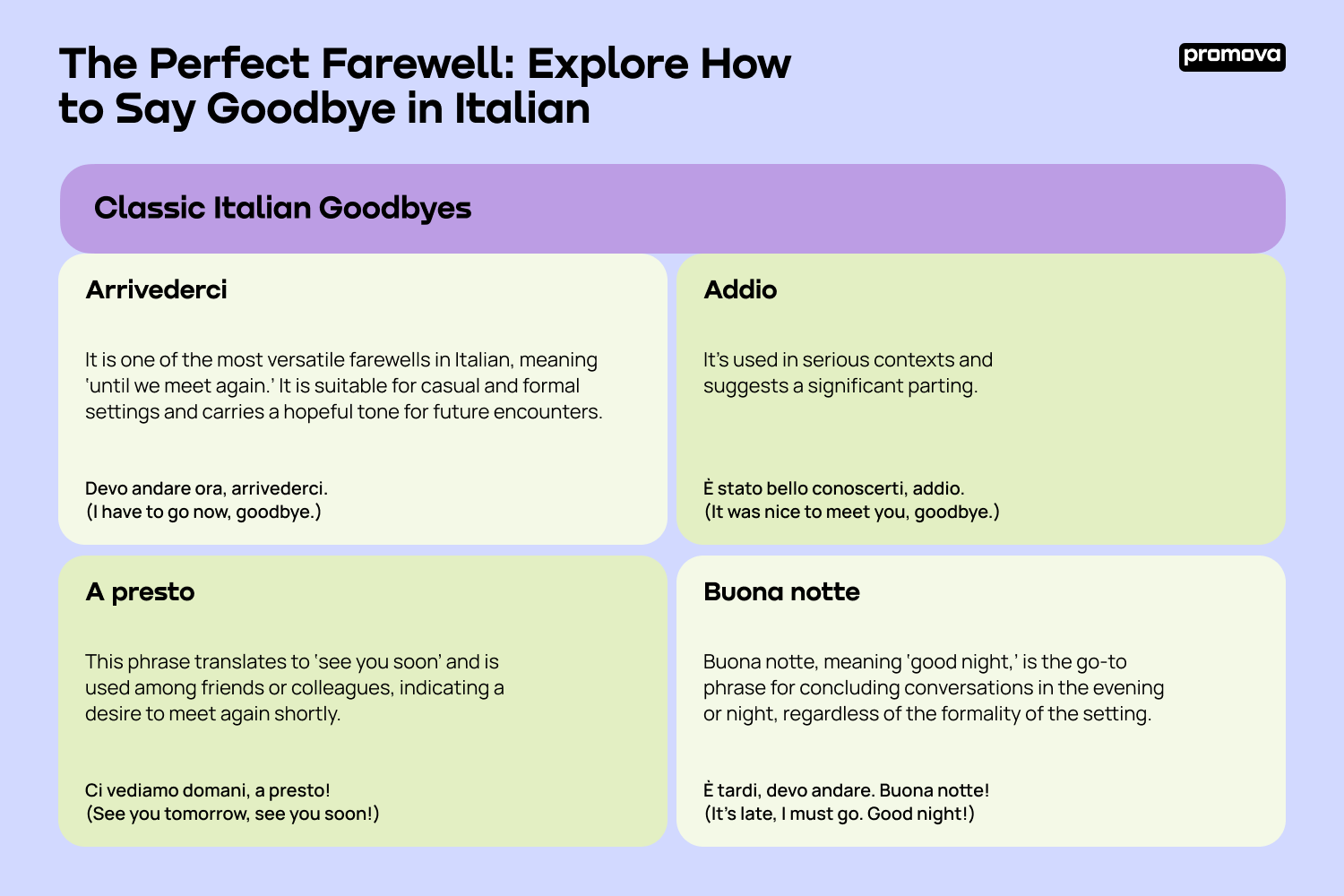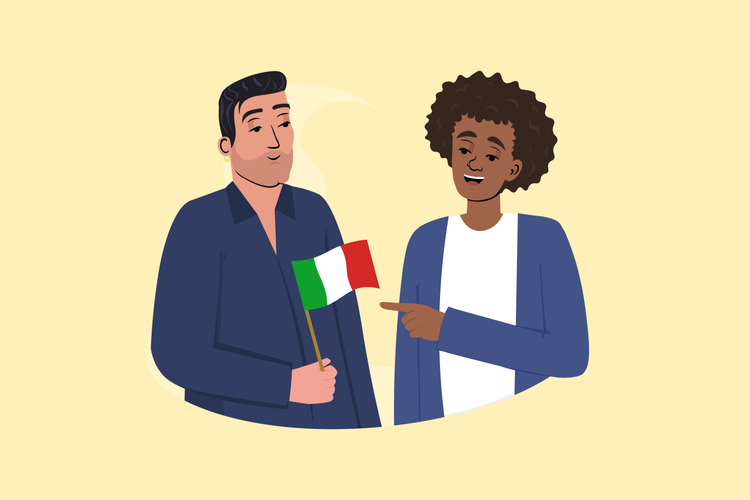The Perfect Farewell: Explore How to Say Goodbye in Italian


You will get a promo code with a discount for our app courses after reading this article.
Contents
In Italy, farewells are more than words; they reflect the culture’s warmth and relationships. Whether it’s a casual ciao among friends or a formal goodbye in Italian, each phrase carries its unique tone and meaning. This article explains the most common farewells, explaining their use and context. You’ll learn not just what to say but how and when to say it.
Arrivederci and More: Classic Italian Goodbyes
How you say goodbye can convey respect, familiarity, or professional courtesy. The right choice of words marks the end of an encounter and acknowledges the relationship between those parting ways. So, how do you say goodbye in Italian?
- Arrivederci [ar.ri.veˈdɛr.tʃi]
It is one of the most versatile farewells in Italian, meaning ‘until we meet again.’ It is suitable for casual and formal settings and carries a hopeful tone for future encounters.
Devo andare ora, arrivederci. (I have to go now, goodbye.)
- Addio [adˈdi.o]
Addio is a heavy farewell, often implying a permanent or long-term goodbye. It’s used in serious contexts and suggests a significant parting.
È stato bello conoscerti, addio. (It was nice to meet you, goodbye.)
- A presto [a ˈprɛ.sto]
This phrase translates to ‘see you soon’ and is used among friends or colleagues, indicating a desire to meet again shortly.
Ci vediamo domani, a presto! (See you tomorrow, see you soon!)
- Buona notte [ˌbwɔ.na ˈnɔt.te]
Buona notte, meaning ‘good night,’ is the go-to phrase for concluding conversations in the evening or night, regardless of the formality of the setting.
È tardi, devo andare. Buona notte! (It’s late, I must go. Good night!)

‘Ciao’ and Other Informal Farewells
In informal interactions, Italian casual goodbyes are as warm and expressive as the people themselves. These laid-back phrases, used among friends, family, or acquaintances in relaxed settings, embody the easygoing aspect of Italian culture. They’re perfect for daily encounters, quick chats, or parting ways in a friendly atmosphere. Here’s how to say goodbye in Italian using informal farewells:
- Ciao [ˈtʃa.o]
Ciao is the Swiss army knife of Italian greetings, used to say hello and goodbye. Its casual nature makes it perfect for informal settings among friends or in friendly, familiar environments.
Ci vediamo, ciao! (See you, bye!)
- Salve [ˈsal.ve]
Although slightly more formal than ciao, salve is still used in casual settings. It’s a polite way to say goodbye, often to people you might not know very well but wish to show respect.
A domani, salve! (See you tomorrow, bye!)
- Ci vediamo [tʃi veˈdja.mo]
Literally meaning ‘we see each other,’ this phrase is commonly used to say see you later in Italian. It implies an upcoming meeting and is often used among friends.
Facciamo una pausa e ci vediamo dopo. (Let’s take a break and see each other later.)
- Alla prossima [ˈal.la ˈprɔs.si.ma]
Translating to ‘until the next time,’ this farewell is a casual and optimistic way to express hope for another meeting in the near future.
È stato un bel pomeriggio, alla prossima! (It was a nice afternoon, until next time!)
Formal Farewells: How to Say Goodbye in Italian Professionally
Regarding professional or formal settings in Italy, how you say goodbye can reflect respect and proper etiquette. These formal farewells are crucial in workplaces or when addressing someone in a position of authority. Here are a few formal farewells, each suited for maintaining a sense of professionalism and courtesy:
- ArrivederLa [ar.ri.veˈder.la]
It is a formal ‘arrivederci’ variant, utilizing the polite ‘Lei’ form. It’s commonly used in professional environments or when addressing someone you have a formal relationship with.
È stato un piacere incontrarLa, arrivederLa. (It was a pleasure to meet you, goodbye.)
- Cordialmente [kor.dʒalˈmen.te]
Meaning ‘cordially’ or ‘kind regards,’ it is often used at the end of formal emails or letters rather than spoken goodbyes, reflecting a professional and respectful tone.
In attesa di una Sua risposta, cordialmente. (Looking forward to your reply, kind regards.)
- Buongiorno/Buonasera [ˌbwɔnˈdʒor.no / ˌbwɔ.naˈse.ra]
While these phrases mean ‘good morning’ and ‘good evening’ in a formal setting, they can also be used to say goodbye, especially when the time of day aligns.
Grazie per la riunione, buonasera. (Thank you for the meeting, goodbye.)
- Distinti saluti [disˈtinti saˈlu.ti]
This phrase, which translates to ‘best regards,’ is another formal way to end a letter or email. It conveys a high level of professionalism.
La ringrazio per la Sua collaborazione, distinti saluti. (Thank you for your cooperation, best regards.)
- La ringrazio [la rinˈɡrats.jo]
Meaning ‘I thank you,’ this expression is a polite way to end a conversation or a meeting, showing gratitude and respect.
Per la Sua disponibilità, la ringrazio. (For your availability, I thank you.)
1
Emotional Goodbyes: Expressive Italian Goodbye Sayings
In Italian culture, emotions often run deep, reflected in the language’s rich array of expressive farewells. These sayings are not just about parting ways; they convey feelings, sincerity, and often a deep personal connection. To say goodbye in the Italian language, use some of these heartfelt farewells:
- Con affetto [kon afˈfet.to]
Meaning ‘with affection,’ this phrase is used when parting from loved ones or close friends. It expresses a warm, heartfelt sentiment.
Mi mancherai, con affetto. (I will miss you, with affection.)
- Con tutto il mio cuore [kon ˈtut.to il ˈmjo ˈkwɔ.re]
Translating to ‘with all my heart,’ it is a deeply emotional farewell, often reserved for intimate relationships or very close friendships.
Addio, con tutto il mio cuore. (Goodbye, with all my heart.)
- Ti penserò [ti penˈse.rɔ]
This phrase means ‘I will think of you.’ It expresses that the person will be in your thoughts, signifying a deeper emotional bond.
Ti penserò ogni giorno. (I will think of you every day.)
- Rimarrai sempre nel mio cuore [riˈmar.rai ˈsem.pre nel ˈmjo ˈkwɔ.re]
Meaning ‘you will always stay in my heart,’ it is often used in deeply emotional goodbyes, where the separation is significant or long-term.
Anche se vai lontano, rimarrai sempre nel mio cuore. (Even if you go far away, you will always remain in my heart.)
- Ti voglio bene [ti ˈvɔʎ.ʎo ˈbe.ne]
It is a common way to express affection, translating roughly to ‘I care for you’ or ‘I hold you dear.’ It’s a versatile phrase used with family, friends, or romantic partners.
Ti voglio bene, non dimenticarlo mai. (I care for you, never forget that.)
Short and Simple Ways to Say Bye in Italian
In the fast-paced rhythm of everyday life, sometimes a quick and straightforward goodbye is all that’s needed. With its efficiency and charm, Italian offers several options for such occasions. These brief farewells are easy to remember and are suitable for a range of everyday situations:
- Bye [baɪ]
Surprisingly, the English ‘bye’ has been adopted into contemporary Italian, especially among the younger generation. It’s trendy and casual.
Bye, ci sentiamo! (Bye, we’ll be in touch!)
- A dopo [a ˈdɔ.po]
Translating to ‘later,’ it is a common and breezy way to say goodbye when you expect to see the person later in the day.
A dopo, in ufficio. (See you later, in the office.)
- Torno subito [ˈtɔr.no suˈbi.to]
Meaning ‘I’ll be right back,’ this phrase is perfect for situations where you’re leaving but will return shortly.
Torno subito, non andare via! (I’ll be right back, don’t go away!)
Master Languages with Promova: Your Gateway to Enhanced Communication
Are you looking to master new languages and enhance your communication skills? Promova is here as your one-stop solution for language learning that’s both engaging and effective. With a rich selection of languages, including English, Italian, French, Spanish, and German, we’ve tailored each course to fit your unique learning style.
With our guided courses, you will be equipped with all the materials you need to navigate and progress through your chosen language. Dive into interactive vocabulary lessons, comprehensive grammar insights, and quizzes that offer real-life scenarios for a practical learning experience.
If English is the language you want to improve, Promova has covered you with various options. Benefit from 1x1 lessons conducted by experienced tutors who will support your needs. These personalized sessions are designed to cater specifically to your progress and obstacles. Once you sign up, you can try our services with a free trial lesson.
Promova isn’t just focused on individual learning; we also provide opportunities for collaborative experiences. Take part in group lessons accessible via the web platform, where you can learn alongside peers and engage in interactive English exercises.
Our blog extends this learning environment, offering a wide range of articles and tips that will help deepen your understanding of the nuances of different languages. From guides on how to tell time in Italian to exploring cultural etiquette in German, the blog is an excellent supplement to your language-learning quest.
Conclusion
In conclusion, Italian offers a rich palette of farewells, from casual ‘ciao’ to heartfelt emotional expressions. Whether in a formal business meeting or parting with a dear friend, these phrases allow you to convey your sentiments appropriately and with cultural sensitivity. Mastering these varied ways of saying goodbye in Italian not only enhances your linguistic skills but also deepens your connection with the Italian culture and its people.
Use your discount and learn languages with Promova
Start learningFAQ
Are there cultural nuances in saying goodbye in Italian that I should be aware of?
Yes, cultural nuances in Italy can influence how goodbyes are expressed. For instance, physical gestures like handshakes or cheek kisses often accompany farewells, depending on the relationship and region. Also, Italians might consider it rude to leave abruptly; a proper goodbye is usually expected. Moreover, the choice between formal and informal farewells depends on familiarity with the person.
Is there a difference in saying goodbye in Italian in the North compared to the South?
Depending on the region, there are numerous ways to say goodbye in Italian. In the Northern regions, farewells might be more reserved and occasionally include local dialect phrases like ‘A reveure’ in Piedmontese or ‘Addio’ in standard Italian. In Southern regions, goodbyes tend to be warmer and more expressive, often accompanied by physical gestures. Phrases like ‘Salutamu’ in Sicilian or the more passionate ‘Te voglio bene assaje’ (I love you very much) in Neapolitan might be used among close friends and family.
Are there any Italian customs or superstitions related to saying goodbye?
Saying goodbye in Italian on a doorstep is considered bad luck, as it’s believed to bring misfortune to the house or the relationship. Instead, farewells are typically said inside or outside but not directly on the threshold. Additionally, Italians often avoid farewells like ‘addio,’ which implies a final goodbye, preferring more hopeful expressions that imply future meetings.
Where can I learn more Italian phrases and expressions?
Several online resources are available for those keen to expand their vocabulary. WordReference is a valuable tool that features forums for discussing language nuances. Additionally, Reverso Context is excellent for understanding phrases within real-life context examples, helping learners grasp the practical usage of expressions. The Italian language learning app by Promova can also be your gateway to mastering new phrases.



Comments